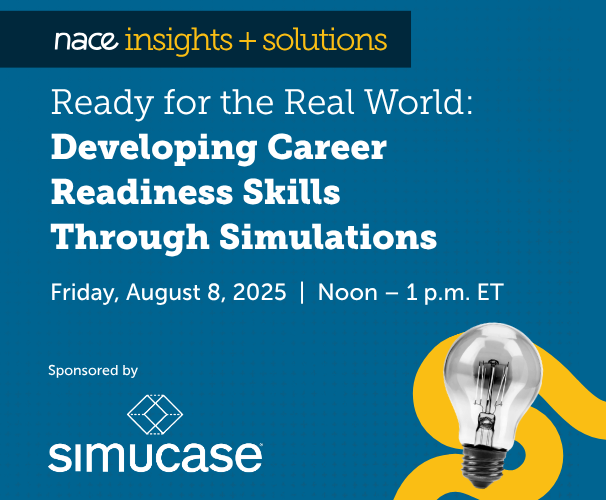NACE Journal, November 2017
In May 2017, Clemson University and the University of Tampa co-hosted a symposium that brought together faculty, career services staff, administrators, student affairs staff, and employers to discuss strategic campus-wide approaches to competency development. The fact that more than 180 attendees from 60-plus institutions, employers, and service providers participated in the day-and-a-half symposium emphasizes the interest in and importance of competency development in college students.
Institutions and organizations on both sides of college recruiting recognize that competency development is essential for student success after graduation. Colleges and universities—oftentimes with the input of their key employer partners—are identifying their own sets of competencies for their students to develop during their college careers.
Many of these schools are then integrating competency development campus-wide by infusing intentional student learning mapped to their competencies into the curriculum and co-curriculum. While these schools all strive to arrive at the same place—program effectiveness—they each travel different paths to get there.
Symposium developers Kristin Walker, associate director of analytics and initiatives in Clemson’s Center for Career and Professional Development, and Tim Harding, associate dean of career development and engagement at the University of Tampa, agree that, no matter the approach, there must be a university-wide culture around competency development for efforts to be effective.
“We started in two completely different areas,” Walker says. “Whereas the University of Tampa started by incorporating competencies into its division strategic plan, we started in-house by infusing competencies into everything within our career center while the university underwent its strategic planning process. Regardless of where you start, competency integration isn’t a recipe where if you don’t do things with the right ingredients in the right order, the cake isn’t going to come out right.”
Becoming More Intentional at the University of Tampa
Harding introduced the “Spartan Ready” career readiness program to the University of Tampa’s president four years ago. His goal was to become more focused on and deliberate about developing the high-demand competencies that are relevant to succeed in the work force.
“[The development of the Spartan Ready program] came from the recognition that, while we knew intuitively that what happened in the curriculum and co-curriculum at the university was helping to develop these skills in students, there was never any intentionality about development and measurement of those competencies, nor were we trying to identify what they are,” Harding explains.
Harding and his team conducted research on competencies and what employers are seeking. They worked with the university’s employer advisory board to validate the ones that were critical to student success, and, from this collaboration, developed a list of competencies for the school.
The Spartan Ready program is based on seven competencies—which act as the program’s pillars—and two foundational, underlying attributes. The program’s seven competencies are:
- Communication—The ability to effectively and efficiently convey and receive information, both formally and informally, using verbal, non-verbal, and writing skills amongst various stakeholders.
- Interpersonal abilities—The ability to develop personal insight in order to engage with others and create meaningful relationships, which will lead to effective collaboration.
- Critical Thinking—The ability to envision and employ analysis, interpretation, and reason using information and data through cognitive processes.
- Organization—The ability to effectively and efficiently manage and/or systematize resources, time, and individuals to accomplish goals and tasks.
- Global Engagement—The ability to understand, appreciate, respect, and learn from the complex social, economic, cultural, and political nature of diverse peoples and their societies, and build meaningful connections and interrelationships.
- Teamwork—The ability to successfully build, lead, manage, motivate, and work with others.
- Self-Awareness—The ability to demonstrate an understanding of how inherent and/or developed personality traits and characteristics contribute to personal and professional success.
Meanwhile, its two foundational attributes are:
- Professionalism—The ability to articulate oneself as a polished professional while using appropriate acumen for a career environment.
- Life Skills—The ability to effectively meet the challenges and expectations of leading a fulfilling life.
The competencies align closely with the NACE career readiness competencies, which were released in 2015.
“We feel like life skills and professionalism transcend everything,” Harding says. “Our definition is more broad than just student success in the workplace. It’s about life success and being involved in the community.”
One of the most important results of the implementation of this program, Harding says, is that the University of Tampa now has a common language spoken across campus when addressing Spartan readiness.
“We don’t necessarily talk about the word ‘competencies’ with people; we’re talking about ‘Spartan readiness’ now,” Harding says. “That makes a difference. It’s a branding that our students, in particular, can identify with a little bit more than if we were talking about having competencies, which sounds pretty lofty.”
Harding was surprised by how students took to and took ownership of the program. Early conversations with students centered on the activities they are taking part in and the skills they are developing, and how they are developing these skills. It resonated with students so strongly that a group of students initiated a mapping session during which they brought in a speaker to talk about Millennials in the workplace and what to expect. Students also worked with career development staff to create a mapping exercise, which helped them think about what they do in their individual leadership roles that is mapped back to the competencies.
Competency Development Resources
For more information and resources about competency development, see:Themes Provide a Framework at Clemson
While Clemson has been focusing on competency development for more than a year, the basis for the initiative has been years in the making.
“Our division has been working on a student life curriculum for several years,” explains Walker, noting that Clemson’s Center for Career and Professional Development is a hybrid department that operates under academic affairs and student affairs. “We’re trying to fit it into our division’s strategic plan. I knew that in championing [a competency development initiative], we’d have to connect to the student life curriculum.”
Walker took the main competencies and their definitions, and the student learning outcomes from the Clemson student life curriculum, along with NACE’s competencies and other sources and did some basic, thematic coding.
“I took anything that anybody had, lumped it together, put their definitions next to it, and grouped things thematically,” she explains. “I went through them with the directors to see what they liked and didn’t like, and discussed the buzzwords we should to add, and [how to] make them unique to Clemson, so if somebody here is talking about leadership, we can be sure they’re defining it the same way we’re defining it.”
During the process, the director of cooperative education said employers often talk about their need for students who are innovative.
“We know a competency has to be measured, and we didn’t know how to measure innovation,” Walker recalls. “We asked what things fell under innovation. What does it take to be innovative? Those are the competencies that are measurable. We liked that [approach] and that’s where we came up with our themes of engagement, innovation, and professionalism.”
Under those themes, Clemson’s core competencies are:
Engagement
- Communication—Engaging in dialogue that leads to productive outcomes and points of connection by effectively articulating one's self to individuals within and outside of one's industry or area of expertise.
- Collaboration—Developing authentic and mutually beneficial relationships by valuing everyone and taking responsibility for one's role within a team.
- Leadership—Being able to recognize, respect, develop, and capitalize on the unique strengths of individuals from all backgrounds, and being an active member in a group that achieves a shared vision.
Innovation
- Adaptability—Taking the initiative to further enhance one's skill set and being creative with ways of thinking or approaches that allow for action, reflection, failure, and resilience in an ever-changing world.
- Analytical Skills—Seizing the opportunity for organizational improvement that prompts critical thinking and problem solving by obtaining, processing, and synthesizing information.
- Technology—Employing current and emerging software and tools to solve general and industry-specific challenges.
Professionalism
- Self-Awareness—Understanding one’s strengths, limitations, emotions, and biases in a variety of situations and articulating how one’s interests, skills, and values align with educational and professional goals.
- Integrity and Ethics—Making choices and consistently acting in a manner that displays integrity (following internal principles, morals, and values) and ethics (following external laws, rules, and norms) in personal and professional settings.
- Brand—Demonstrating the continual development of a positive impression or image in every facet of life while seeking feedback from others to ensure congruence between one’s intended and perceived reputation.
Clemson is now in the second year of its competency development program. Last spring, Walker met with the resident advisers, orientation ambassadors, and peer advisers for Clemson’s “Aspire to Be Well” program for the 2017-18 academic year.
“Our center’s executive director and I went into all of their classes, and we had these students do a self-assessment,” Walker says. “Where am I now? What do I want to work on as an RA and OA? The process has helped students more accurately assess where they currently are and where they want to be by the end of an experience.”
A student, for example, may not be proficient at communication. By breaking down the competency, the student can pinpoint specific areas on which to focus.
“Communication is an overarching competency,” Walker explains. “But we look at all the skills that make up communication. The student might be great at written communication, but his or her oral communication has some room for improvement. This assessment allows students to work with their supervisors and focus on developing the competencies that will help them in future internships, co-ops, jobs, and more. With this program, they can now be more strategic.”
A Common Starting Point
While an entry point for a competency development program depends on the context at each individual campus—be it through a division’s strategic plan, through career services programming, or through another gateway—there is a starting point that colleges and universities can use to help launch their initiative.
Walker and Harding feel that the common aspects of their efforts are foundational and chose these areas on which to build the symposium programming.
“We honored the fact that each university or institution is in a different place,” Walker explains. “Each has different situation, values different things, and finds different people in different seats who they can either leverage or not. However, there are common elements to consider.”
These four “pillars” framed the sessions and discussions at the symposium, and included:
- Pillar 1—Competency learning, development, and articulation should be made apparent and infused into the curriculum and co-curriculum to provide opportunities for students to actively demonstrate competency development and readiness. Framing programs, services, and one-on-one conversations around competencies provides students with multiple touchpoints throughout their time at the institution.
- Pillar 2—Competency development and career readiness should be integrated broadly into the life and culture of the institution, and their value should be reflected in institution/division/department strategic plans and general education. Cultivating and sustaining relationships with upper administration, faculty, staff, students, and employers is essential for making a competency initiative part of the fabric and vocabulary of the institution.
- Pillar 3—Institution-wide competency integration requires an investment of financial and human resources to reimagine how institutions prepare all undergraduate and graduate students for a lifetime of success. Keeping a pulse on trends and issues affecting higher education and the evolving world can help ensure an institution-wide competency initiative remains relevant.
- Pillar 4—Competency development should be assessed, measured, and tracked in curricular and co-curricular experiences. Collecting outcomes data will help individual students realize developmental progress and help institutions work toward continued improvement.
“We recognized that we have very different approaches to university-wide competency development and are implementing it in very different ways, and we both are having success,” Harding explains. “Although there is no one model that exists that everyone can adopt, these are foundational principles that everyone can build upon as a starting point.”







